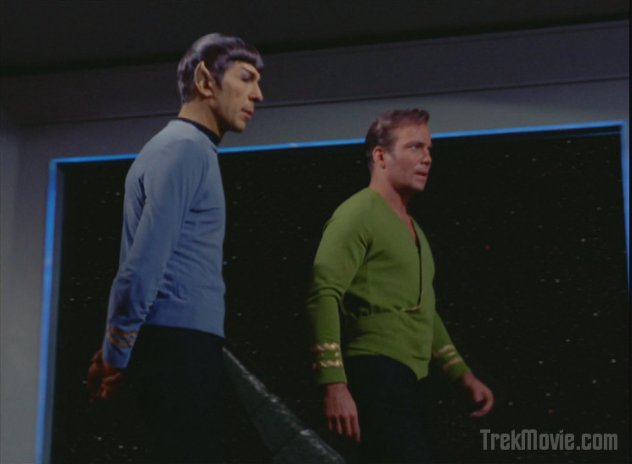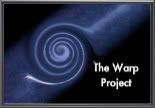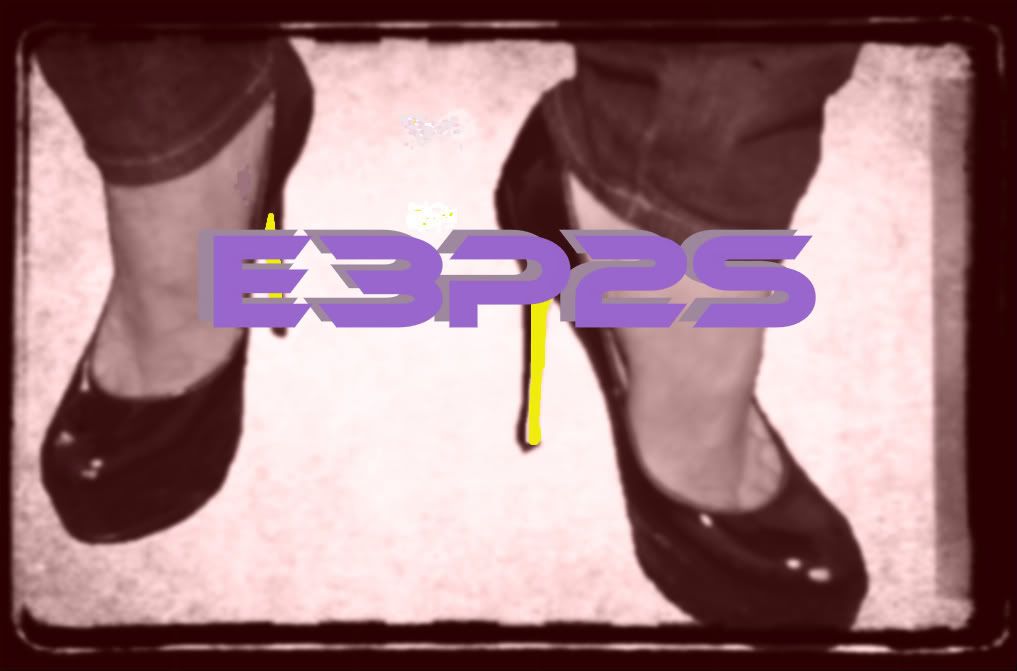TOS: Episode 35: The Doomsday Machine
Oh my god! Rubble and asteroids. Seven planets--an entire system, excluding the star, have been destroyed. Only a supernova would seem to have such potential. And yet, the star is intact. After further investigation of the area, strangely, the two inner most planets to the system, Spock discovers, are still intact. So begins "The Doomsday Machine."
Episode Summary
Episode 35 begins with Kirk appearing in his pea green, faux wrap, gold glitter trimmed top, and puff-bottom black trousers. The trousers represent a look common to the era of American television--pant bottoms tucked into boots. It carries a kind of allusion to genie style pantaloons cinched tight at mid-calf. This tucked in pant style is also common to the Star Trek movies from III through V, in which Kirk consistently wears his black trousers tucked into black boots.
In the background, additional controls and lights have been added to the set of the Enterprise bridge. Unfortunately, instead of fancying up the set, it's caused it to look far more like put on cardboard.
The crew succeeds in following a systematic scan of the damaged area in space, thus finding a floating and damaged U.S.S. Constellation (toy in space! toy in space!). Realizing she must have been attacked, Kirk puts us on red alert. Christmas lights flash in the background.
Strangely, even in the face of severe damage, life support appears to be operative about the damaged star ship. But scanners show no life signs aboard. Kirk leads an away team, leaving Spock in command of the Enterprise. Beaming aboard, the away team--Scotty, and McCoy included--investigate a seriously damaged star ship set. Cardboard tubing and plastic wires hang everywhere. Further, there appear to be not only no survivors on the Constellation, there is also no obvious evidence of previous human life. That is, there are no bodies, and no remains. Until, one stunned, and unspeaking Star Fleet officer is found aboard deep within the bowels of the ship. Treated by McCoy, we discover he is the Captain of the Constellation, and that he is so shocked by what happened he can barely face retelling the story. Finally, he tells us that, facing attack from a-still-as-yet-unnamed-enemy, the Captain beamed his crew to a planet's surface in an attempt to save them. Immediately following beaming all but himself to the planet, the transporters were destroyed. Then, the entire planet was consumed by the enemy while the crew on its surface screamed to their Captain for help. We discover, then, that the Captain's stunned (and unshaven) state is a direct result of his having been unable to help his crew. The future hasn't solved every problem, then. Men still must shave regularly, even in the face of grief, lest they develop facial hair.
The Captain of the Constellation finally is able to report on his sighting of the enemy, and his tapes of the star ship offer Spock additional information for us. The enemy turns out to be an unmanned robot emiting pure anti-protons with which it destroys entire planets to then consume for its own fuel. We discover the robot originated from far outside the galaxy, and is on a path of destruction into the most populated heart of our own galaxy. Hearing this information, Kirk theorizes that the machine was built as a doomsday device--too powerful for anyone to truly control, but built as a kind of false threat against 'the other side' of a war--and was released by a people no longer existing. We discover, then, example of Hannah Arendt's concern--the more developed our technology, the less able we are to control it, and the more it appears the results of it are outside fault or responsibility.
The robot appears in pursuit of the Enterprise, the ship's energy apparently attracting the machine's attention. Just before the away team would have been beamed back, Enterprise transporters and communications are knocked out. Scotty, Kirk, and a previously unseen crew member Washburn are left aboard. (I wonder who might die if someone must?) The Captain of the Constellation, and McCoy had previously beamed back. Soon, the Constellation Captain appears as trouble for Spock, acting out of a need for vengence in the face of his own failure, and speaking as though he will exert his power of rank to out rule Spock's own wise counsel. Strangely, though the Captain has clearly been under psychological duress as a result of losing his entire crew, no one fights his claiming command of the Enterprise. The way regulations are cited here ignores rules we hear later that allow for an officer being "emotionally compromised", and thus unable to fill their post. Here, the Captain would only be relieved of duty if the doctor could certify him physically or psychologically unable to lead. But doing so would depend on McCoy having run a full diagnostic examination of the Captain, and clearly he hasn't had time to do so. This situation comes into direct conflict with scenes we see in later Star Trek episodes in which Captains are relieved of duty in quick order as a result of doctor intervention. McCoy's heated demeanor comes in useful here as he throws a fit over the clearly problematic situation.
Aboard the Constellation, Kirk and Scotty work on repairs to try and get the ship operating again. Kirk succeeds in making the viewing screen functional, just in time to see his Enterprise under attack. He pushes Scotty to get engines working for ship's manuevering. Scotty succeeds just as the Enterprise would have been sucked into the doomsday machine itself. They rush the Constellation roughly towards the machine, barely able to control its direction.
On the Enterprise, we see the Constellation Captain struggling to face that he is making poor decisions, and that the Enterprise crew is relieving him of duty. In the moment Spock relieves the Captain of command, and demands him to be arrested, or leave, we discover "Vulcans never bluff." Finally, Spock succeeds in re-claiming leadership of the ship, but shortly after, the Captain fights off his security detail and escapes into the bowels of the ship (apparently he likes it in ship's bowels). For what purpose we do not yet know, but we can only assume it is to attempt a take over of the Enterprise. Shortly, however, we discover the Captain of the Constellation steals a shuttle craft and ventures off into space in pursuit of the alien robot. Having lost everything when his crew died, he now intends to chase vengence through the throat of the alien robot. Unfortunately, it seems unlikely that his doing so will succeed in destroying the robot, and instead only succeed in killing himself. We watch the Captain slowly goes crazy as he is eaten by the alien vessel without appearing to actually damage the robot itself.
Episode Tidbits
Okay, are we bored yet? My point-by-point retelling of the episode details has got to be laborious to read. But, it is one of those stories that holds wonderful tension in its design-- the madness of the Constellation Captain in the face of his own failure reveals a brutal sort of rationality. He is right in his intention to destroy the machine, and his determination to think creatively to do so. And yet it is clear he is driven to do so by his own agony, and gambles too much to relieve it. The Captain was Kirk's friend, and struggles (briefly) with the loss of the Captain for what appears to be no good reason. Still, the pain of the loss inspires Kirk's thinking in how to possibly destroy the machine. In his risky willingness to face the machine, he is almost killed himself, as the transporters of the Enterprise are damaged, and the Constellation is used to explode inside the machine. Still, Kirk succeeds, barely, at destroying the machine.
The episode ends with a speech by Kirk about the horrors of the H-bomb, and its parallels to their own Doomsday Device. Though mostly pitched as an action-driven sci-fi, then, Episode 35 is also used to offer political commentary for citizens of the Cold War.
The sort of attack against the alien vessel we see in this episode is one repeated in the most recent Franchise movie. There too a ship pushing itself full charge down the throat of an alien vessel, and then exploding there is repeated as the primary strategy for destroying the enemy. The idea Kirk keeps pushing of an ultimate weapon of war is also seen through the presence of the Romulan vessel in that movie. A ship from the future carries with it such advanced technology that the Romulan mining vessel out paces all other defenses in the Star Fleet universe. As such, the Romulan vessel is a doomsday device within the retooled Star Trek timeline.
Interestingly, there is also a character parallel between the Spock we see here and the Spock of movie XII, the recent Star Trek. Here, Spock's logic tells him to avoid attack of the enemy vessel because it appears they cannot succeed. Instead, he will rely on saving the crew remaining on board the Constellation, and then escaping to rendevous with, and warn Star Fleet. The belief here is that only multiple ships could have a chance of destroying the enemy robot. In the movie, Spock also avoids feelings of vengence, and seeks to quell his anger by rendevousing with Star Fleet to speak in high counsel about what is to be done. Again, the belief being that one ship cannot solve the problem. In both Episode 35, and the recent movie, however, we are taught to see that Spock's reasoning of this sort is faulty. It is exactly one ship that will make all the difference, when that ship is led with quick and creative, bold maneuvering. In both cases, the doomsday device they face must be destroyed by one ship rammed in explosive fashion down the throat of the offensive machine. Spock's reliance on group planning goes against the impulsive brilliance of Kirk's singular risk taking, and yet, it is also what makes Kirk's leadership possible. It is only because Spock here was focused on rescuing the crew, and then rendevousing with Star Fleet that Kirk's bold escapades became possible. Had Spock acted against the enemy ship instead, Kirk would have been without ability to act. We see again, then, that the two characters are intertwined. What makes one's traits possible, are the traits of the other one. Kirk and Spock in balance with each other.
The Entire Star Trek Universe at High Speed
Subscribe to:
Post Comments (Atom)








No comments:
Post a Comment